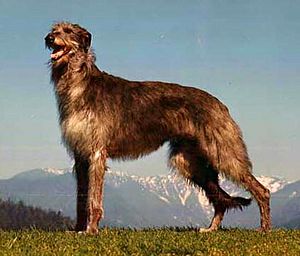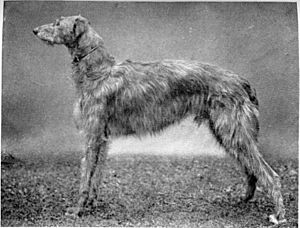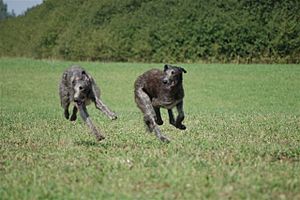Scottish Deerhound facts for kids
 |
|||||||||||||||||||||||||||||||||
| Other names | Deerhound | ||||||||||||||||||||||||||||||||
|---|---|---|---|---|---|---|---|---|---|---|---|---|---|---|---|---|---|---|---|---|---|---|---|---|---|---|---|---|---|---|---|---|---|
|
|||||||||||||||||||||||||||||||||
|
|||||||||||||||||||||||||||||||||
| Domestic dog (Canis lupus familiaris) | |||||||||||||||||||||||||||||||||
The Scottish Deerhound is a very large dog breed. It is a type of sighthound, which means it hunts using its sight and speed. These dogs were originally bred in Scotland to hunt large red deer.
Scottish Deerhounds look a lot like Greyhounds. However, they are bigger and have stronger bones. They also have a rough, shaggy coat. The Scottish Deerhound is closely related to the Irish Wolfhound. In fact, it helped create the Irish Wolfhound breed in the late 1800s.
Contents
History of the Scottish Deerhound
The Scottish Deerhound has a long history. An old stone carving called the Hilton of Cadboll Stone shows large dogs chasing a deer. This carving is about 1,200 years old. However, we don't know for sure if these dogs are directly related to today's Deerhounds. The breed became widely known as the Scottish Deerhound in the early 1800s. Before that, they were just called different types of greyhounds.
Hunting with Deerhounds
Deerhounds were used to hunt red deer until the late 1800s. They would chase deer using their speed. This type of hunting is called coursing. Hunters would get the dogs as close to the deer as possible. Then, they would release one or two Deerhounds to run the deer down. If successful, the chase would usually be over in just a few minutes.
Later, hunting methods changed. People started using modern rifles and smaller hunting areas. Slower tracking dogs became more popular than fast Deerhounds. These tracking dogs would follow wounded animals.
Deerhounds and Scottish Clans
In Scotland, the old clan systems ended. This meant that Deerhounds became more of a sporting dog for rich landowners. But regular people also bred and hunted with them when they could. Deerhounds were fast and quiet hunters. They could quickly catch any animal the size of a hare or larger. Both nobles and poachers valued them highly.
The breed faced a tough time in the late 1800s. Many large Scottish estates were divided into smaller ones. Few people kept Deerhounds anymore. The new popular way to hunt was stalking and shooting. This only needed a tracking dog, like a collie, to find wounded animals. A few estates still used Deerhounds for their original job. But mostly, the breed was kept alive by a few people who showed them in dog shows.
Deerhounds Around the World
Deerhounds were also used for hunting in other places. For example, Teddy Roosevelt wrote that some hunters in Canada and America used them for hunting wolves and deer. In Australia, Deerhounds were used to hunt kangaroos and wild boars. Sometimes, they were crossed with other dogs to create breeds like the Kangaroo Dog.
What Scottish Deerhounds Look Like
Scottish Deerhounds look like Greyhounds but are much larger. They also have stronger bones. While Greyhounds are faster on smooth ground, Deerhounds can outrun them on rough or wet terrain. Their large, rough-coated look comes from the cool, wet, and hilly Scottish Highlands where they worked.
Size and Appearance
Male Scottish Deerhounds are usually 30 inches (75–80 cm) tall or more at the shoulder. They weigh between 85 to 110 pounds (40–50 kg). Females are at least 28 inches (70 cm) tall and weigh 75 to 95 pounds (35–43 kg). They are one of the tallest sighthound breeds.
They have a harsh, wiry coat that is about 3–4 inches long. They also have a slightly softer beard and mustache. Their ears are small, dark, and soft. They usually fold back against the head.
Coat Colors
Modern Deerhounds usually have coats in different shades of gray. Blue-gray is a very popular color. In the past, Deerhounds could also be true brindle, yellow, or red fawn. These colors were often seen with a wire-haired coat. However, these genes seem to be lost now because dog show breeders prefer a longer coat. A small white patch on the chest and toes is allowed. A tiny white tip on the tail is also okay. But a white stripe on the head or a white collar is not accepted.
Head and Features
Their head is long and their skull is flat. They have a tapering muzzle. Their eyes are dark, usually dark brown or hazel. Their teeth should meet in a perfect scissor bite. The tail is long and covered with hair. It should almost reach the ground.
Temperament
Scottish Deerhounds are known for being gentle and very friendly. They are usually calm and eager to please their owners. They have a dignified way about them. However, remember they are sighthounds. This means they have a strong natural urge to chase things.
Exercise Needs
Young Deerhounds need a lot of exercise to grow up healthy and strong. This doesn't mean they need a huge house. But they do need regular access to a safe, fenced area where they can run freely. They should not just be walked on a leash or kept in a small yard. This would not be good for their health. People who live in cities can still own a Deerhound. They just need to take their dog to parks often for long runs and games of fetch.
Young Deerhounds can sometimes be destructive if they don't get enough exercise. But adult Deerhounds often just want to relax and sleep most of the day. They do best with another Deerhound to play with and a large space to exercise in. They are gentle and calm indoors. They are usually good with visitors and children. However, because of their large size, they should be watched closely when around very young children.
Health
Scottish Deerhounds usually live for about 8 to 9 years. Some common health issues for this breed include heart problems (cardiomyopathy) and a type of bone cancer (osteosarcoma). They can also suffer from bloat, which is a serious stomach condition.
Like other sighthounds, Deerhounds have some unique body features. These features probably developed because they were bred for speed and sight when hunting. Scientists have studied their blood and found some differences compared to other dog breeds. Some of these differences are common in all sighthounds, while others might be unique to the Scottish Deerhound.
Notable Scottish Deerhounds
- Dusk: This dog was a wedding gift to the Danish writer Karen Blixen. She wrote about Dusk often in her books and letters. Dusk was also shown in the movie Out of Africa.
- Maida: This was the famous Deerhound of writer Walter Scott.
- Foxcliffe Hickory Wind
Images for kids
-
Sir Walter Scott's Deerhound, Maida, was included in his statue in Perth, Scotland
See also
 In Spanish: Lebrel escocés para niños
In Spanish: Lebrel escocés para niños





